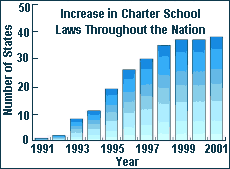 | |||||||||
| |||||||||
|
|||||||||
Parent Involvement Among Hispanics Targeted
Equating Public Choice with Public Education
Close-Up: No Child Left Behind—Supporting Public Charter Schools
Tips for Parents
Desktop Reference for No Child Left Behind
Parent Involvement Among Hispanics Targeted
U.S. Secretary of Education Rod Paige recently announced a $500,000 grant to the Hispanic Scholarship Fund and the Hispanic Scholarship Fund Institute to help create the Partnership for Excellence in Latino Higher Education, a three-year initiative to increase parental involvement in K-12 schools in Latino communities and to prepare Latino children to enter college.
The partnership seeks to develop effective outreach strategies to Latino parents in order to empower them with information and resources to increase the success of their children in school.
"The No Child Left Behind Act will help ensure that every child—regardless of race, income or zip code—receives a quality education," said Secretary Paige. "But if we're to achieve this bold goal, we must get parents and entire communities more involved in their children's education."
The grant is provided through the U.S. Department of Education's Fund for the Improvement of Education. The funds will be used to research and analyze the scope and effectiveness of existing resources, develop new materials, and create and implement a distribution strategy based upon needs assessments in Latino communities.
Equating Public Choice with Public Education
By Patricia Harvey, St. Paul, Minn.
While school choice stirs a national debate, in Saint Paul, Minn., it means one thing for families—a world of opportunities. Every winter, we host a citywide Parent Information Fair at our downtown civic center for thousands of Saint Paul families who are trying to decide on a school. At this event, families and students speak with principals and staff at trade-show-style booths representing more than 100 public schools and programs, along with dozens of charter, private and parochial schools.
The fair is just one example of this district's commitment to public school choice. Saint Paul is home to the first magnet and the first charter schools in the nation.
The choices for elementary students include magnet schools that have a special focus on academic subjects, from the arts to aerospace, and include international baccalaureate programs for the primary years. All of our secondary schools are open to all students in the city and also offer specialty programs for helping students develop goals and plans for their futures.
We are working hard to implement the choice provisions of No Child Left Behind with our current school choice system. Over this summer we worked aggressively to ensure that all parents with children in schools identified as needing improvement were fully aware of their options. We were able to give all of nearly 500 students requesting a move from those schools their first or second choice school.
In addition, we have a three-year action plan to implement district wide research-based practices in literacy, math and science so that all students will get access to comparable academic rigor, whether they attend their neighborhood school or a magnet school across town.
While we are pleased at how well our system is working, we know it can be better. We are engaging our community to strengthen a system of choice that advances three goals:
| "I hope to erase the stigma and shame associated with harassment and bullying so young people feel empowered to report the experiences and demand better treatment. ... When you can use your own experiences to empower people, you are no longer paralyzed by what people have said about you." —Miss America 2003, Erica Harold, during an interview for the Oct. 15 show of Education News Parents Can Use. |
- Educational Excellence. We need to ensure that our schools are doing more than making adequate yearly progress. When I arrived in Saint Paul in 1999, I put 11 schools on academic probation because their test scores were flat or declining. Since then, most of those schools have made remarkable improvements and are once again good choices for students.
- Equity. We've been working very hard in Saint Paul on ensuring that our diverse community members have equal access to the school choice process. While the overall percentage of students of color in our district has climbed over the past decade from 45 to 67 percent, our schools are not segregated. We have a good balance of African American, Hmong, Hispanic and white students at every school.
- Efficiency. We want to ensure that as few dollars as possible are diverted from the classroom to transportation and other costs associated with maintaining a system of choice. Compared to other school districts nationally, Saint Paul has expanded public school choice without dramatically increasing transportation costs.
Patricia Harvey is superintendent of Saint Paul Public Schools in Minnesota. Prior to joining Saint Paul in 1999, she was the chief accountability officer for Chicago Public Schools and also served as a principal and teacher for more than 25 years in that district.
Close-Up On: No Child Left Behind—Supporting Public Charter Schools
Charter schools were developed in the early 1990s to increase parental control, to promote innovation and to provide students increased educational options within the public school system. Thirty-eight states, the District of Columbia and Puerto Rico have charter school laws. Approximately 2,700 charter schools nationwide are serving half a million students.
Under Title V, Part B, Subpart 1 of the No Child Left Behind Act of 2001 (NCLB), the Public Charter School Program provides financial assistance for the planning, design or initial implementation of charter schools and to evaluate the effects of such schools.
 Source: Charter Laws Across the States 2001: Ranking Scorecard and Legislative Profiles, Center for Education Reform. |
In awarding competitive grants, the U.S. Department of Education gives priority to states that demonstrate progress in increasing the number of high-quality charter schools that are held accountable in their charter for meeting clear and measurable objectives for the educational progress of their students. States also receive priority if they allow for an appeals process for the denial of applications for a charter school and ensure that each charter school has a high degree of autonomy over its budget, among other criteria.
School choice is a key provision of the Title I accountability provisions in NCLB. Parents with children in schools that fail to meet standards for at least two consecutive years may transfer their children to a better-performing school, including a charter school, within their district.
Tips for Parents!
You are the most important advocate for your child's education. You should feel comfortable visiting your child's school and examining the curriculum. Some things you may want to ask your child's teacher or principal:
- May I see a copy of this school's report card?
- May I see my child's test results? Please explain in what areas my child is improving and in what subjects she may need help.
- What subjects does my child seem to enjoy the most? What can I do at home to reinforce and encourage that interest?
- If my child needs extra help, what resources are available before or after school or on the weekends to make sure she gets the help she needs?
One-stop guide! Desktop Reference for No Child Left Behind
The U.S. Department of Education just produced a 180-page desktop reference manual to the landmark education reform law No Child Left Behind.
The guide, No Child Left Behind: A Desktop Reference, offers a program-by-program look at the major reforms under the new law. It describes how the act's four guiding principles—accountability, flexibility and local control, parent options and research-based practices—bear on many of these programs. The manual covers the following sections of the law:
- Title I: Improving the Academic Achievement of the Disadvantaged
- Title II: Preparing, Training and Recruiting High-Quality Teachers and Principals
- Title III: Language Instruction for Limited English Proficient and Immigrant Students
- Title IV: 21st-Century Schools
- Title V: Promoting Informed Parental Choice and Innovative Programs
- Title VI: Flexibility and Accountability
- Title VII: Indian, Native Hawaiian and Alaska Native Education
- Title VIII: Impact Aid
- Title IX: Unsafe School Choice Option
- Title X: McKinney-Vento Homeless Education Assistance
Credits
U.S. Department of Education
The Achiever is published by the Office of Intergovernmental and Interagency Affairs, U.S. Department of Education (ED).
Secretary of Education
Rod Paige
Assistant Secretary
Laurie M. Rich
Senior Director
John McGrath
Executive Editor
Sarah Pfeifer
Editor
Nicole Ashby
Contributing Writer
Patricia Harvey
Designer
Jason Salas Design
Questions or comments:
Editor
The Achiever
U.S. Department of Education
400 Maryland Avenue, S.W.
Room 5E217
Washington, DC 20202
Fax: 202-205-0676
NoChildLeftBehind@ed.gov
Electronic subscriptions and address changes: NoChildLeftBehind@ed.gov
Paper Subscriptions and address changes:
ED Pubs
P.O. Box 1398
Jessup, MD 20794
1-877-4ED-PUBS (433-7827)
edpubs@inet.ed.gov
Information on ED programs, publications and initiatives:
Information Resource Center
U.S. Department of Education
400 Maryland Avenue, S.W.
Washington, DC 20202
1-800-USA-LEARN (872-5327)
usa_learn@ed.gov http://www.ed.gov/about/offices/list/oiia/irc.html
The Achiever contains news and information about public and private organizations for the reader's information. Inclusion does not constitute an endorsement by the U.S. Department of Education of any products or services offered or views expressed.
Unsubscribe
To unsubscribe from The Achiever:
- Send email to listproc@inet.ed.gov
- Write in the body of the message: unsub nochildleftbehind
